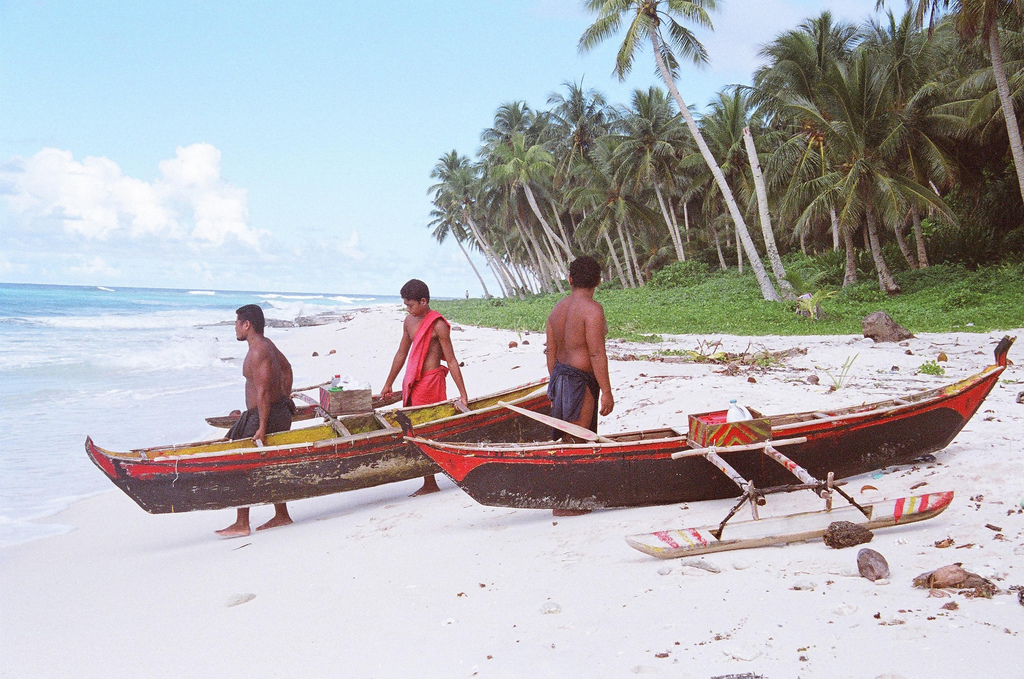Yap State, Micronesia
The Federated States of Micronesia is a country with an area greater than the USA but a land area smaller than New York. Why? Because it’s made up entirely of tiny islands scattered over a vast swathe of the Pacific Ocean. 1000 miles east of the Philippines is the westernmost state of Yap. 100 miles east of Yap island, Yap State’s Outer Islands begin. They are atolls hundreds of miles apart from one another, no more than four or five square miles each, and home to some of the most isolated people on the planet. These people live on the world’s most jaw-dropping beaches, swim every day in the clearest turquoise waters and eat fresh lobster, octopus, shark and turtle on a daily basis.

Men going out fishing in traditional dugout canoes, Fais, the Outer Islands, Yap state, Federated States of Micronesia
The islands of Yap State have been inhabited for three to five thousand years by people who originally emigrated from the Philippines or Indonesia. The rulers of ancient Yap held command over a vast empire that atretched for over 1000km east through the Outer Islands and even to the western end of Chuuk, the nearest of the other three states of the Federated states of Micronesia.
Though “discovered” by Europeans in 1526, no permanent trading stations were set up here until the late 19th Century. Until that time Yapese society was structured by an extremely complex and fluid caste system. Not only were there multiple castes, but every village had its own ranking within its caste. The ranking of one village over another could easily change as they gain advantage, whether by war or other means, and new sanctions would then be placed on the weaker village by the stronger, such as restrictions on the amount of fish or sea creatures they could catch. When the Germans finally enforced peace on the islands in the late 19th Century, the caste system froze. Its structure has remained absolutely identical to the present day.
The people of the Outer Islands are the lowest caste. They are also darker skinned than the Yapese and have different languages. On Yap island, Yapese is spoken, but the Outer Islands, which stretch for 800km east of Yap island, have three separate languages: Ulithian (the westernmost, and the one spoken on nearby Fais island), Woleaian (roughly central) and Satawalese (the easternmost).
The pre-colonial rulers of Yap kept control of such a vaste swathe of the Pacific Ocean partly due to their skill as navigators. In simple dugout canoes they could travel thousands of kilometres, navigating only by the position of the stars, the patterns of the waves and currents. In the Outer Islands people still travel using the same canoes and the same methods to this day.
It was also their skill as navigators that allowed them to travel to distant Palau to quarry stone for their famous stone money. You will see these giant, circular stone slabs scattered all over Yap island, in every village and at the side of every lane winding its way through the island’s dense vegetation. Up to 13 feet in diametre, roughly 7,000 have remained since half of the original number were destroyed by the Japanese during the war. Their value came from the difficulty and danger involved in getting them and bringing them back on rafts attached to the backs of canoes. They are still used today in marriages, to buy land, to pay for services or as payment of damages to an aggrieved party. Everyone knows who owns which piece so when ownership changes the stone is usually not even moved.
Yap’s capital, Colonia (population 11,000) has flights only from “nearby” Guam and Palau and only with Continental Airways. You can get to Guam or Palau with Continental Airways from the Philippines, Hawaii or Cairns in Australia. Flights are extremely expensive.
If you have no time to get to the Outer Islands there are a few small communities of Outer Islanders on Yap Island itself. You will notice them because both men and women go topless and wear only a piece of cloth wrapped around their waist and legs.
Colonia has a few extremely expensive hotels for divers who come from the world over for Yap’s spectacular diving and abundance of manta rays. If you don’t fit into this category then you should definitely get in touch with the Yap Visitors’ Bureau before arriving. They can get you a place at Bechiyal Beach or others like it where you can pitch your tent for US$5 a night or or can organise you your own wooden beach hut for $35 a night (2008 prices).
Getting around Yap island is fairly cheap by taxi but also very easy by hitch hiking. Everyone on Yap island speaks English as it is the official language taught in schools and even on the Outer Islands enough people speak English to make travel and coomunication no problem at all.
Click here for my blog on Yap and its Outer Islands. It’s 9248 words and 24 photos.
Leave a Reply